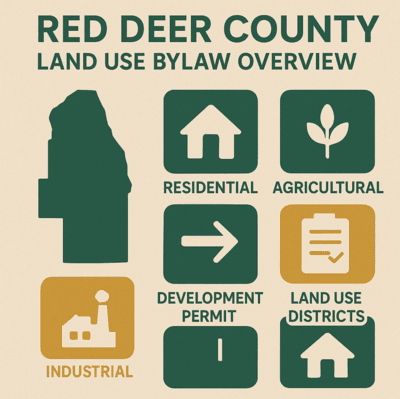Overview of Red Deer County Land Use Bylaw
The Red Deer County Land Use Bylaw 2022/26 regulates land use, development, and zoning in the county. This bylaw outlines the rules and guidelines for property development, zoning classifications, setbacks, and the development permit process. It is essential for property owners, developers, and businesses to understand and adhere to these regulations when planning new developments or making changes to existing properties.
Key Zoning Districts in Red Deer County
- Agricultural District (AG): Primarily designated for farming, ranching, and agricultural operations.
- Residential Districts (R-1, R-2, etc.): Areas intended for residential development, including low-density rural residential, estate residential, and high-density residential zones.
- Commercial Districts (C-1, C-2, etc.): Areas designated for retail, office, and other commercial uses.
- Industrial Districts (I-1, I-2): Designated for industrial and manufacturing uses.
- Special Districts (SD): Includes specific areas such as parks, public service facilities, and recreational developments.
Property Line Setbacks
Setbacks define the minimum distance between structures and property lines. In Red Deer County, typical setbacks are as follows:
- Residential Buildings: Typically a 7.6-meter (25-foot) setback from the front and rear property lines, and a 3-meter (10-foot) setback from the side property lines.
- Accessory Buildings: Setbacks can be reduced depending on zoning but generally require a 1.5-meter (5-foot) setback from the side and rear property lines.
Development Permit Process
A Development Permit is required for most types of construction, renovation, or land-use changes in Red Deer County. The process ensures that the proposed development complies with zoning and land-use regulations.
Steps for Applying for a Development Permit:
- Identify the zoning district of your property to understand allowable uses.
- Prepare necessary documents such as site plans, building designs, and environmental studies (if required).
- Submit your development permit application to the county's Planning & Development Department for review.
- Wait for approval before proceeding with construction or development.
For detailed instructions and forms, please refer to the county’s development permit guidelines.
Permitted and Discretionary Uses
The bylaw outlines which land uses are permitted by right (permitted uses) and which require additional approval (discretionary uses). For example:
- Permitted Uses: Single-family homes, agricultural uses, and essential public infrastructure.
- Discretionary Uses: Home-based businesses, commercial developments, and other uses that may require additional review for compatibility with surrounding properties.
Non-Conforming Uses
Non-conforming uses refer to properties or activities that were legally established under previous bylaws but no longer comply with the updated regulations. Such uses may continue but are subject to restrictions and may require further compliance when expanded or altered.
Overlay Districts
Certain areas in Red Deer County are subject to additional regulations due to environmental concerns, flood risks, or proximity to public infrastructure. These overlay districts may impose stricter development rules to protect public safety and the environment.
Recent Amendments and Updates
Red Deer County regularly updates its Land Use Bylaw to address emerging trends, changes in land use, and new legislative requirements. Recent amendments may address issues such as renewable energy installations, environmental protections, and residential zoning flexibility.

